DDR5 Demystified - Feat. Samsung DDR5-4800: A Look at Ranks, DPCs, and Do Manufacturers Matter?
by Gavin Bonshor on April 7, 2022 8:00 AM EST- Posted in
- Memory
- Intel
- Samsung
- Micron
- SK Hynix
- DDR5
- Alder Lake
- DDR5-4800
- 12th Gen Core
- Z690
CPU Performance Benchmarks: DDR5-4800
To show the performance of DDR5 memory in different configurations, we've opted for a more selective and short-form selection of benchmarks from our test suite. This ranges from tests on application opening, rendering, web, and compression.
All of the tests were run with all of the memory at default (JEDEC) settings, which means DDR5-4800 CL40, regardless of the configuration, e.g, 2x16, 2x32, and 4x16 GB.
Web: Speedometer 2
Our web test for this analysis is Speedometer 2, which is a test over a series of JavaScript frameworks to do three simple things: built a list, enable each item in the list, and remove the list. All the frameworks implement the same visual cues, but obviously apply them from different coding angles.
Our test goes through the list of frameworks, and produces a final score indicative of ‘rpm’, one of the benchmarks internal metrics.
We repeat over the benchmark for a dozen loops, taking the average of the last five.
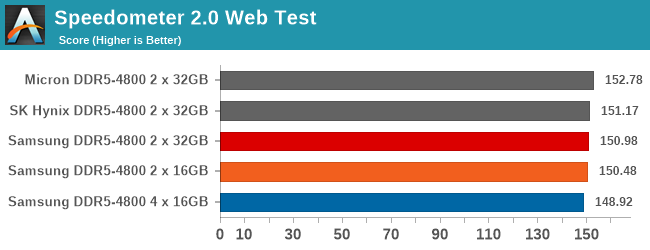
In Speedometer, the 2Rx8/1PDC DDR5-4800 kit performed best of all out of the Samsung memory, with the 1Rx8/1DPC performing closely behind the 2 x 32 GB kit. The 1Rx8/2PDC (4 x 16 GB) kit from Samsung technically performed the slowest of all, but the performance difference was within a 3% margin of error from top to bottom.
The Micron 2 x 32 GB proved the best out of all the memory we tested, albeit without much difference from the rest of the 2 x 32 GB kits tested.
AIDA64: 6.60: link
AIDA64 Extreme has a hardware detection engine unrivaled in its class. It provides detailed information about installed software and offers diagnostic functions and support for overclocking. As it is monitoring sensors in real-time, it can gather accurate voltage, temperature, and fan speed readings, while its diagnostic functions help detect and prevent hardware issues. It also offers a couple of benchmarks for measuring either the performance of individual hardware components or the whole system. It is compatible with all 32-bit and 64-bit Windows editions, including Windows 11 and Windows Server 2022.
We are using AIDA64 in this instance to gather memory bandwidth data based on read speed, write speed, copy speed, and memory latency.
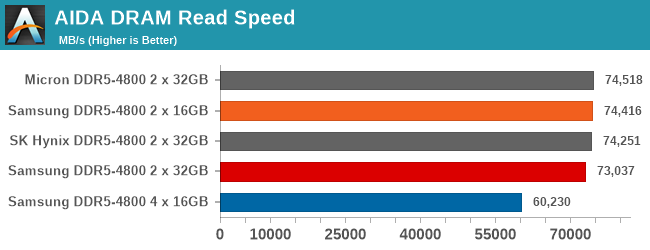
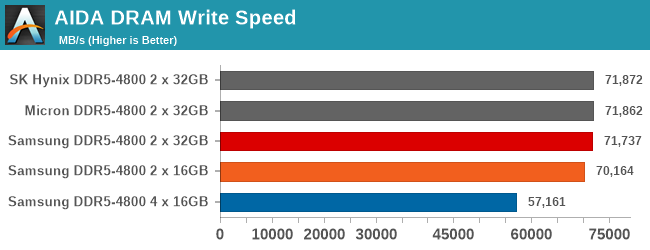
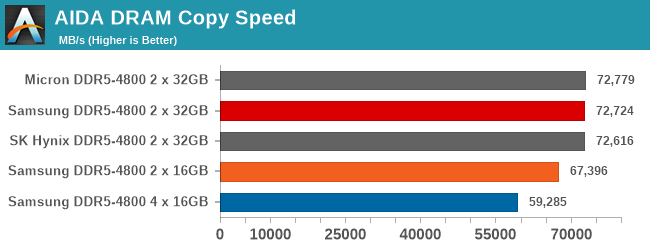
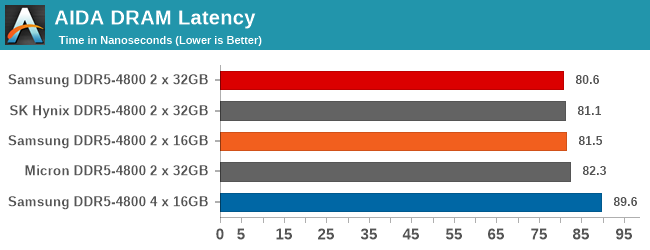
Looking at raw memory benchmarks from AIDA64, all of the 2 x 32 GB kits perform competitively against each other. Meanwhile the Samsung 4 x 16 GB experienced drops in performance across the board, with both read bandwidth and write bandwidth being impacted. There's also a notable latency penalty to consider when using four DIMMs (2DPC) versus two DIMMs (1DPC).
The most interesting result here may very well be the Samsung 2 x 16 GB (1Rx8) kit. While it's fully competitive with read speeds, it loses just a little bit of ground on write speeds, and a little more ground on all-out copies. In what's admittedly a memory-focused test, it's a very early indicator that dual ranked DIMMs are the sweet spot in terms of performance, and that losing a rank does incur penalties. All of which is then further exacerbated by going to 2DPC.
WinRAR 5.90: link
Our WinRAR test from 2013 is updated to the latest version of WinRAR at the start of 2014. We compress a set of 2867 files across 320 folders totaling 1.52 GB in size – 95% of these files are small typical website files, and the rest (90% of the size) are small 30-second 720p videos.
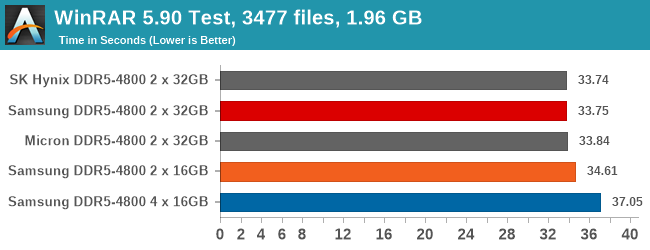
Looking at performance in WinRAR, this is where the higher density 2Rx8 memory showed its dominance. The kits with 16 Gb chips in 2Rx8 outperformed the 16 Gb 1Rx8, with the 2 x 16 GB Samsung kit notably outperforming the same memory running with four UDIMMs in a 2DPC configuration.
Rendering - Blender 2.79b: 3D Creation Suite
A high-profile rendering tool, Blender is open-source allowing for massive amounts of configurability, and is used by a number of high-profile animation studios worldwide. The organization recently released a Blender benchmark package, a couple of weeks after we had narrowed our Blender test for our new suite, however their test can take over an hour. For our results, we run one of the sub-tests in that suite through the command line - a standard ‘bmw27’ scene in CPU only mode, and measure the time to complete the render.
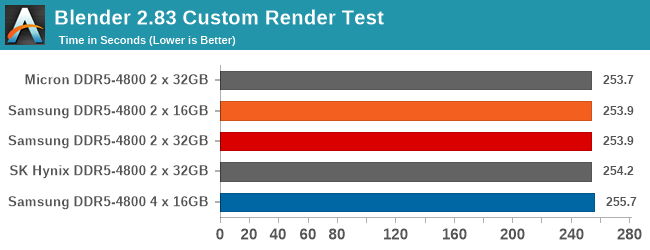
Focusing on rendering, the difference between the 2 x 32 and 2 x 16 GB kit was marginal. The 4 x 16 GB Samsung kit was technically the worst performer out of the bunch, but for all practical purposes, all 5 kits may as well be tied.
Rendering - Cinebench R23: link
Maxon's real-world and cross-platform Cinebench test suite has been a staple in benchmarking and rendering performance for many years. Its latest installment is the R23 version, which is based on its latest 23 code which uses updated compilers. It acts as a real-world system benchmark that incorporates common tasks and rendering workloads as opposed to less diverse benchmarks which only take measurements based on certain CPU functions. Cinebench R23 can also measure both single-threaded and multi-threaded performance.
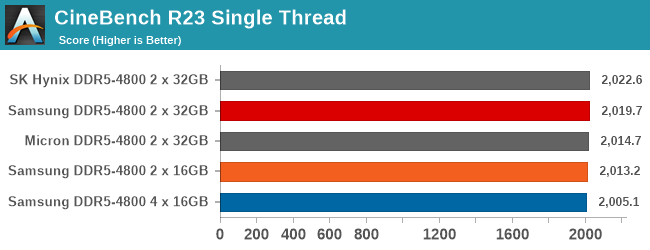
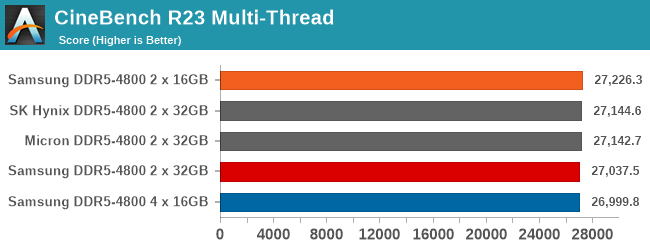
Using CIneBench 23, there wasn't much difference between the 2 x 32 GB kits in the single-threaded test. In the multi-threaded test, the Samsung 2 x 16 GB kit actually performed better than the 2 x 32 GB kits, underscoring how all of the kits are essentially tied in this workload.
Rendering – POV-Ray 3.7.1: Ray Tracing - link
The Persistence of Vision Ray Tracer, or POV-Ray, is a freeware package for as the name suggests, ray tracing. It is a pure renderer, rather than modeling software, but the latest beta version contains a handy benchmark for stressing all processing threads on a platform. We have been using this test in motherboard reviews to test memory stability at various CPU speeds to good effect – if it passes the test, the IMC in the CPU is stable for a given CPU speed. As a CPU test, it runs for approximately 1-2 minutes on high-end platforms.
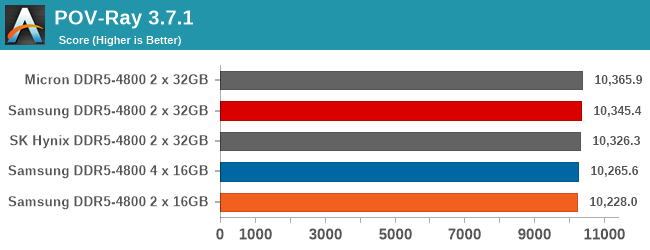
In our POV-Ray testing, the Micron kit performed slightly better than the rest, with Samsung's 2 x 32 GB kit coming a close second. Both variations tested with the 16 GB sticks were slightly behind its higher density counterparts. There was around a 0.36% hit in performance when using four 16 GB memory sticks versus using two.


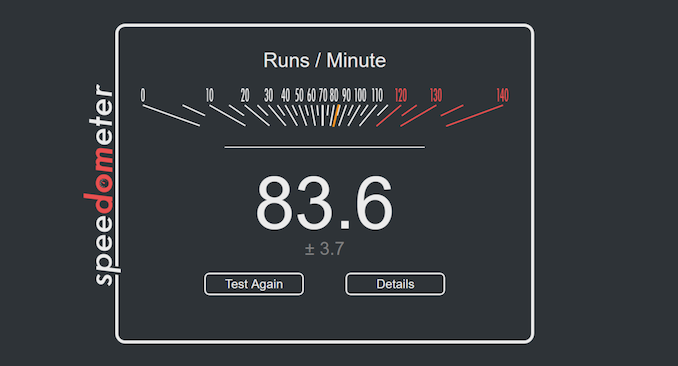








66 Comments
View All Comments
Oxford Guy - Saturday, April 9, 2022 - link
Going on four decades since the Apple Lisa and still no standard ECC on the desktop.WaltC - Saturday, April 9, 2022 - link
One thing I didn't see here that would have been instructive is the location of the memory controller--DDR5 in this case--which I gather is in the CPU? There will be differences there, of course, and we'll know a lot more when AMD introduces its PCIe5 CPUs & buses later this year. The memory controller is an integral part of ram performance, of course. It also would have been interesting to do a bit of DDR4 comparisons--not necessarily at the "same" clocks--but for DDR5 clocks versus the fastest XMP clocks (stable clocks) available with DDR 4 at the present time. That is going to be of interest to a lot of people I'm thinking...;)The_Assimilator - Sunday, April 10, 2022 - link
What pressing problem with desktop DRAM exists that would be instantly solved by adding ECC and thus further increasing cost and complexity?Oxford Guy - Monday, April 11, 2022 - link
Instantly? It was solved almost 40 years ago.Adramtech - Sunday, April 10, 2022 - link
Micron doesn't get enough credit for their current DRAM and NAND lineupeldakka - Wednesday, April 13, 2022 - link
IMO, a better use of a turn-based-strategy (TBS) game like Civ6 is how long a late game end-of-turn computer AI player turn takes than for FPS.As long as FPS is acceptable, for a TBS, the most important number is that end-of-turn time. It can take minutes to process the AI players turns. The reduction in that (whether on CPU or RAM benchmarks - GPU is mostly irrelevant) thumb-twiddling time would be much more informative than FPS.
Oxford Guy - Thursday, April 14, 2022 - link
My understanding of the sloth of recent versions of Civ is due the use of such high-level programming language (scripting) that speed is squandered for ease/quickness of development.How much developers should be rewarded for producing slow but cheap-to-make code is a question.
If recent CIv games were in assembly they would fly. Of course, no developer of large programs does that due to development cost and code portability. However, I bet there are speedier yet not too onerous solutions that would make Civ much less sluggish. The question for the developer is ‘Why bother?’ As long as people continue to buy slower and slower games there is no incentive to make more optimized code.
dicobalt - Thursday, April 14, 2022 - link
Samsung is the only DRAM vendor bringing a new fab online this year, the rest will be in Q4 2024. I hope you like expensive DDR5. Price fixing will happen again, they will be convicted again, and the consequences will be nowhere near the profit made. Everything is perfectly normal.Adramtech - Friday, April 15, 2022 - link
the last price fixing charges were dropped recently for lack of evidence.Oxford Guy - Saturday, April 16, 2022 - link
The fix for the fix.